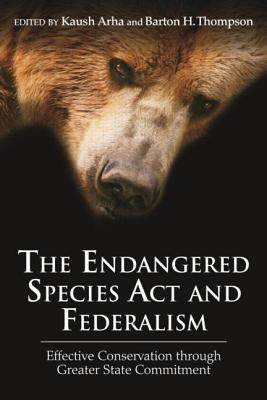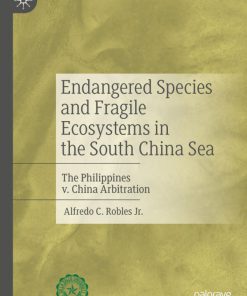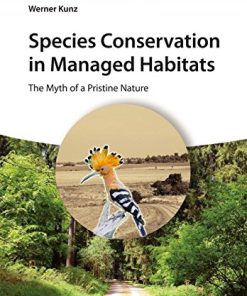The Endangered Species Act and Federalism Effective Conservation through Greater State Commitment 1st Edition by Kaush Arha, Barton H Thompson 1136522208 9781136522208
$50.00 Original price was: $50.00.$25.00Current price is: $25.00.
The Endangered Species Act and Federalism Effective Conservation through Greater State Commitment 1st Edition by Kaush Arha, Barton H Thompson – Ebook PDF Instant Download/DeliveryISBN: 1136522208, 9781136522208
Full download The Endangered Species Act and Federalism Effective Conservation through Greater State Commitment 1st Edition after payment.

Product details:
ISBN-10 : 1136522208
ISBN-13 : 9781136522208
Author: Kaush Arha, Barton H Thompson
States today play a major role in implementing and enforcing environmental laws such as the Clean Air Act, Clean Water Act, and the Resource Conservation and Recovery Act. A thirty year review of ESA identified state leadership in species conservation as a necessary element in better conserving the nation‘s imperiled species, yet the theoretical and practical reasons and applications of an enhanced state role are little understood and have not been subjected to any meaningful analysis. This book, for the first time, presents the legal and policy analysis for federalism considerations in implementing ESA. The book undertakes a comprehensive analysis of the economic rationale for federalism in ESA administration; compares administration of ESA to other major environmental statutes; reviews various tools under the existing Act to enhance state role in species conservation; evaluates major case studies to determine roles the state can play in species conservation and recovery; and concludes with policy recommendations to encourage greater state involvement in species conservation.
The Endangered Species Act and Federalism Effective Conservation through Greater State Commitment 1st Table of contents:
Part I Introduction
1 Federalism under the Endangered Species Act
Federalism under Today’s Endangered Species Act
Listing Decisions
Recovery Plans
Consultations by Federal Agencies
Takings Prohibitions
Section 6
Federal Funding of State Biodiversity Efforts
State Biodiversity Programs
Schema of this Book
Frameworks
Opportunities for State and Local Involvement under the ESA
Case Studies
Concluding Thoughts
References
Endnotes
Part II Frameworks
2 An Economic Assessment of Environmental Federalism: The Optimal Locus of Endangered Species Authority
The Economics of Environmental Federalism
Applying the Transaction-Cost Approach
National Endangered Species Regulation
Decentralized Endangered Species Regulation
Conclusion
References
Endnotes
3 Cooperative Federalism and the Endangered Species Act: A Comparative Assessment and Call for Change
Framework: Tools of Cooperative Federalism
Focus: Federalism and the Endangered Species Act
Cooperative Agreements
Enforcement Limitation
Federal Preemption
Comparison: The Clean Water Act and Coastal Zone Management Act
Consequences: The Costs of Incoherent Federalism
Weak State Programs
Public Hostility to the ESA and “The Feds”
Frictional Federal–state Relations
Scapegoating of the States
Conclusion
References
Part III Opportunities for State and Local Involvement under the ESA
4 Listing Decisions, Conservation Agreements, and State–Federal Collaboration: A Litigation Perspective
Overview of ESA Litigation
Litigation Concerning Section 7 of the ESA
Litigation Concerning Sections 9 and 10 of the ESA
Litigation Concerning Section 4 of the ESA
The Role of State–Federal Cooperation under ESA Section 4
State–Federal Relationship in Section 4 Cases
Winter-Run Chinook Salmon48
Barton Springs Salamander63
Oregon Coastal Coho Salmon88
Flat-tailed Horned Lizard108
Klamath Mountains ESU of Steelhead124
Short-leaved Dudleya135
Agency Development of PECE and CCAA Policy
Pece
CCAA Policy
Litigation under the New Policies
How to Assess Litigation Risk in the Post-PECE World
Opportunities for State–Federal Cooperation under Other Sections of the ESA
Conclusion
Endnotes
5 The Evolution of Federalism under Section 6 of the Endangered Species Act
Legislative History of Section 6 of the ESA
1973 House ESA Bill
Confusing Reconciliation of 1973 House and Senate Bills
Regulatory Interpretation of 1973 Section 6 Provisions
Narrow Interpretation of Section 6(g)
Creation of Project-based Section 6 Cooperative Agreements
1976 Amendments
State Role in the ESA Less Than Envisioned in 1973
1977 and 1978 Amendments Increased Cooperative Agreements
1977 Amendments Removed Obstacles to Cooperative Agreements
1978 Amendments Expanded Section 6(c) to Include Plants
Regulations Promulgated for 1977 and 1978 Section 6 Amendments
1980 Amendments Increased Funding Authorization
1982 Amendments Focused on Federal Funding Share
1988 Amendments Broadened Scope and Sought Stable Funding
Implementation of Section 6 Cooperative Agreements
Judicial Interpretation of Section 6
Broadened Use of Section 6 Funding Authorization
Evolution of State Role under Other ESA Provisions
Development of Federal Agency Policy on State ESA Involvement
Increased State Involvement under Expanded Use of ESA Section 10
State Involvement in Safe Harbor and Candidate Conservation Agreements
Different Direction for State ESA Role under New Agreements
Conclusion
References
Endnotes
6 California’s Natural Community Conservation Planning Program: Saving Species Habitat amid Rising Development
NCCP: Origin and Motivations
What Is Conservation Planning under the NCCP Act?
Environmental Protection in California
Drawbacks of Project-by-Project Review and Permitting
Moving from CESA to NCCP
Relationship of NCCP to ESA
Supporters and Opponents
The Southern California Coastal Sage Scrub Pilot Program
NCCP Program Performance
NCCP “Scorecard”
Grant Funding for Planning
Grant Funding for Implementation
Evolution of the NCCP Act
Collaboration with USFWS and National Marine Fisheries Service
Effect on State and Federal Wildlife Agencies
Continuing Challenges
Funding for Planning and Implementation
Leadership
Time Frame
Institutional Capacity
Implementation Commitments
Other Initiatives
Conclusion
References
Endnotes
Part IV Case Studies
7 The Karner Blue Butterfly: Wisconsin’s Statewide Habitat Conservation Plan
Karner Blue Butterfly Habitat and Range
Karner Blue Butterfly Is Deemed Endangered
Wisconsin’s HCP for the Karner Blue Butterfly
WDNR and USFWS Roles in the Wisconsin Initiative
Accomplishments of the Wisconsin Initiative
Performance
Present Situation
Observations
Conclusion
References
8 The Red-cockaded Woodpecker: Conservation through Statewide Safe Harbor Agreements
Background
Comparing and Contrasting Safe Harbor Agreements and Habitat Conservation Plans
Conceptual Framework Overview
Implementation Overview
North Carolina Sandhills Red-cockaded Woodpecker Safe Harbor Program
Involving States in Safe Harbor
Discussion and Observations
State Wildlife Agency Participation and Motivation
Adequate State Authority
Value of Certainty for Participating Landowners
Adequate Funding
Performance and Accomplishments to Date
Conclusion
Acknowledgments
References
Endnotes
9 Saving Salmo: Federalism and the Conservation of Maine’s Atlantic Salmon
The Natural History of the Atlantic Salmon
Conservation Efforts Prior to the 1993 Listing Petition
The Era of Making Salmon
Salmon Farming Enters the Picture
The 1992 Prelisting Recovery Plan
Actions Regarding the Ocean Fisheries for Atlantic Salmon
International Attention to Aquaculture Impacts on Wild Salmon
The Proposed Listing as Threatened and the Special Section 4(d) Rule Deal
The 1993 Petitions
The 1995 Proposed Listing as Threatened
State of Maine’s Response to the 1995 Proposed Listing
The Maine Conservation Plan of 1997
Withdrawal of the Proposed Listing
Breakdown of the Deal and the Final Listing as Endangered
The 1999 Annual Report on the Maine Conservation Plan
The 1999 Status Review and Re-initiation of the Proposed Listing
The 2000 Listing as Endangered
The Impact of the Clean Water Act’s Cooperative Federalism
Recovery Planning for the Maine Salmon: State–Federal Cooperation at Last?
Conclusion
Epilogue
Endnote
References
10 Oregon Coastal Coho Restoration and the Endangered Species Act
Oregon Coastal Coho
Historical Context
Traditional Salmon Conservation
Watershed Restoration and Water Quality
Northern Spotted Owls and the Northwest Forest Plan
Listing Petition and State Response
Building the OCSRI
Memorandum of Agreement Between Oregon and NMFS
The “No List” Decision
Initial Listing Decision
Oregon Plan Implementation
Conservation Planning
Results
ESA Implementation
Section 4(d) Take Limits and Guidance
Alsea Valley and Delisting
Policy for Evaluation of Conservation Efforts
Trout Unlimited and Relisting
Lessons for Recovery Efforts
Common Vision
Roles and Responsibilities
Working Relationship
Conclusion
References
Endnotes
11 Grizzly Bear Conservation in the Greater Yellowstone Ecosystem: A Case Study in the Endangered Species Act and Federalism
Natural History of Grizzly Bear
Distribution
Physical Characteristics
Habitat Characteristics
Population Characteristics
Grizzly Bear Conservation in the GYE
From Being Hunted to a Species of Concern
Grizzly Bear Deemed Threatened under the ESA
Road to Recovery for Grizzlies in GYE
Critical Habitat Designation
Interagency Grizzly Bear Study Team (IGBST)
Interagency Grizzly Bear Coordinating Committee (IGBC)
Interagency Grizzly Bear Management Guidelines
Recovery Plan
Recovery Zones
Population Monitoring
Effective Habitat
1993 Recovery Plan Goals for the Greater Yellowstone Ecosystem
Major Judicial Decisions Influencing Grizzly Recovery
Recovery Achieved
Scrimmage to Delist the Grizzly in the GYE
Governors Appoint a Citizen Roundtable
Grizzly Bear Conservation Strategy for the GYE
Primary Conservation Area (PCA)
Population Criteria
Habitat Criteria
Yellowstone Grizzly Coordinating Committee (YGCC)
Present State of Affairs
From Threatened to Recovery to Litigation: Observations
Historic Range and Present Dilemma
Grizzly Recovery: Need for Participatory Planning and Management
Grizzly Recovery: Research Based Management
The Role of the IGBC
The Role of Governors
Grizzly Conservation: Use of Threatened and Endangered Designation
Prompt Delisting When Appropriate
Grizzly Conservation: Spillover Effect into Gray Wolf Conservation
Conclusion
References
Endnotes
Part V Concluding Thoughts
12 Toward Greater State and Local Commitment
The Arguments for Greater State Involvement
Current State and Local Involvement
Potential Federalism Reforms
Listings
Threatened Species
State Involvement in Recovery Efforts
Criteria for Downlisting and Delisting
Species Conservation Committees
Section 6 Cooperative Agreements
Funding
Conclusion
References
Endnotes
People also search for The Endangered Species Act and Federalism Effective Conservation through Greater State Commitment 1st:
integrated energy management
integrated maintenance
integrated maintenance management system
integrated maintenance llc
energy maintenance and management inc
Tags: The Endangered Species, Federalism Effective, Greater State, Kaush Arha, Barton H Thompson
You may also like…
Politics & Philosophy
Psychology - Psychotherapy
Science (General)
Politics & Philosophy - Sociology
Psychology - Psychotherapy
Psychology - Psychotherapy
ACT Made Simple An Easy to Read Primer on Acceptance and Commitment Therapy Russ Harris
Education Studies & Teaching - School Education & Teaching
Mathematics Education and Other Endangered Species From Intuition to Inhibition 1st Edition Vinner
Psychology - Psychotherapy
History & Research












